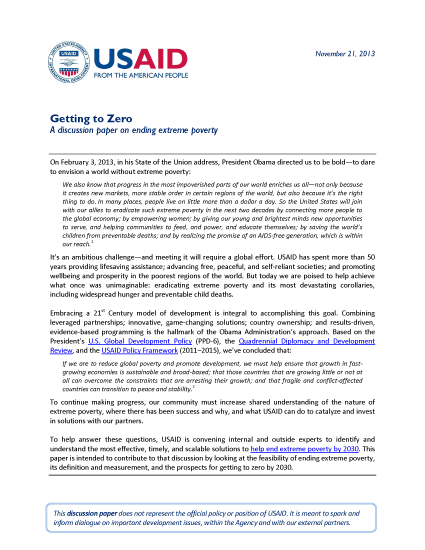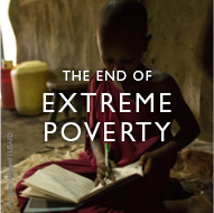- What We Do
- Agriculture and Food Security
- Democracy, Human Rights and Governance
- Economic Growth and Trade
- Education
- Ending Extreme Poverty
- Environment and Global Climate Change
- Gender Equality and Women's Empowerment
- Global Health
- Water and Sanitation
- Working in Crises and Conflict
- U.S. Global Development Lab
A discussion paper on ending extreme poverty
November 21, 2013
On February 3, 2013, in his State of the Union address, President Obama directed us to be bold—to dare to envision a world without extreme poverty:
We also know that progress in the most impoverished parts of our world enriches us all—not only because it creates new markets, more stable order in certain regions of the world, but also because it’s the right thing to do. In many places, people live on little more than a dollar a day. So the United States will join with our allies to eradicate such extreme poverty in the next two decades by connecting more people to the global economy; by empowering women; by giving our young and brightest minds new opportunities to serve, and helping communities to feed, and power, and educate themselves; by saving the world’s children from preventable deaths; and by realizing the promise of an AIDS-free generation, which is within our reach.
It’s an ambitious challenge—and meeting it will require a global effort. USAID has spent more than 50 years providing lifesaving assistance; advancing free, peaceful, and self-reliant societies; and promoting wellbeing and prosperity in the poorest regions of the world. But today we are poised to help achieve what once was unimaginable: eradicating extreme poverty and its most devastating corollaries, including widespread hunger and preventable child deaths.
Embracing a 21st Century model of development is integral to accomplishing this goal. Combining leveraged partnerships; innovative, game-changing solutions; country ownership; and results-driven, evidence-based programming is the hallmark of the Obama Administration’s approach. Based on the President’s U.S. Global Development Policy (PPD-6), the Quadrennial Diplomacy and Development Review, and the USAID Policy Framework (2011–2015), we’ve concluded that:
If we are to reduce global poverty and promote development, we must help ensure that growth in fast-growing economies is sustainable and broad-based; that those countries that are growing little or not at all can overcome the constraints that are arresting their growth; and that fragile and conflict-affected countries can transition to peace and stability.
To continue making progress, our community must increase shared understanding of the nature of extreme poverty, where there has been success and why, and what USAID can do to catalyze and invest in solutions with our partners.
To help answer these questions, USAID is convening internal and outside experts to identify and understand the most effective, timely, and scalable solutions to help end extreme poverty by 2030. This paper is intended to contribute to that discussion by looking at the feasibility of ending extreme poverty, its definition and measurement, and the prospects for getting to zero by 2030.
Read the full discussion paper: Getting to Zero
This discussion paper does not represent the official policy or position of USAID. It is meant to spark and inform dialogue on important development issues, within the Agency and with our external partners.









Comment
Make a general inquiry or suggest an improvement.